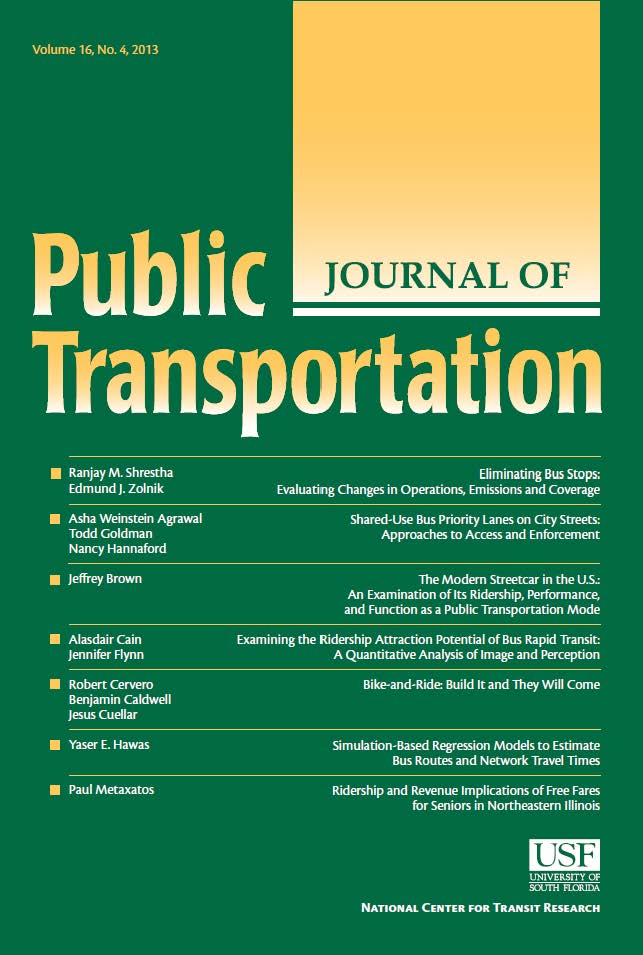Multi-objective optimization of demand responsive transit operations based on dynamic passenger requests using maximum time delay rate
IF 2
4区 工程技术
Q3 TRANSPORTATION
引用次数: 0
Abstract
Demand-responsive transit (DRT) offers on-demand service for comfortable and convenient trips. Despite these advantages, efficient DRT operation requires addressing several considerations. This study resolves the conflict between passengers wanting quick travel and operators seeking maximum revenue by formulating a multi-objective mixed-integer nonlinear programming model (MINLP) to maximize revenue and minimize total travel time. Additionally, DRT operators should balance the benefits of accepted passengers, concerned about increased travel time from new passengers, and requesting passengers who intend to use DRT. To address this, unlike previous studies with fixed time windows, this study introduces the maximum time delay rate (MTR), setting a proportional threshold for each accepted passenger's travel time based on their scheduled travel time, incorporating behavioral economics principles. In this view, the utility of increased or decreased time varies according to the scheduled travel time, considered a sunk cost. When the increased travel time from a new request is within the allowable range, the request is accepted, then the passenger decides whether to choose DRT over other modes. We apply our methodology to dy namic passenger requests generated from taxi data in Incheon, South Korea. For each combination of operational parameters of DRT, we plot a Pareto optimal set of revenue and total travel time. The results demonstrate the substantial influence of MTR and minimum fare distance on passenger numbers and travel time in DRT operations. This study's methodology and results help DRT operators and the public find desirable operation strategies.
利用最大时延率对基于动态乘客请求的需求响应型公交运营进行多目标优化
需求响应式公共交通(DRT)提供按需服务,出行舒适方便。尽管有这些优势,但高效的 DRT 运营需要考虑多个因素。本研究通过制定一个多目标混合整数非线性编程模型(MINLP),解决了乘客希望快速出行与运营商追求最大收益之间的矛盾,从而实现收益最大化和总出行时间最小化。此外,DRT 运营商应平衡已接受的乘客(担心新乘客增加旅行时间)和打算使用 DRT 的乘客的利益。为解决这一问题,与以往使用固定时间窗口的研究不同,本研究引入了最大时间延误率(MTR),根据每位已接受乘客的预定旅行时间,结合行为经济学原理,为其旅行时间设定一个比例阈值。在这种观点中,时间增加或减少的效用随预定旅行时间的变化而变化,被视为一种沉没成本。当新请求增加的旅行时间在允许范围内时,该请求被接受,然后乘客决定是否选择 DRT 而不是其他方式。我们将这一方法应用于韩国仁川出租车数据生成的动态乘客请求。对于 DRT 的每种运营参数组合,我们都绘制了收入和总旅行时间的帕累托最优集。结果表明,地铁和最低票价距离对 DRT 运营中的乘客数量和旅行时间有很大影响。这项研究的方法和结果有助于 DRT 运营商和公众找到理想的运营策略。
本文章由计算机程序翻译,如有差异,请以英文原文为准。
求助全文
约1分钟内获得全文
求助全文
来源期刊

Journal of Public Transportation
TRANSPORTATION-
CiteScore
6.40
自引率
0.00%
发文量
29
审稿时长
26 days
期刊介绍:
The Journal of Public Transportation, affiliated with the Center for Urban Transportation Research, is an international peer-reviewed open access journal focused on various forms of public transportation. It publishes original research from diverse academic disciplines, including engineering, economics, planning, and policy, emphasizing innovative solutions to transportation challenges. Content covers mobility services available to the general public, such as line-based services and shared fleets, offering insights beneficial to passengers, agencies, service providers, and communities.
 求助内容:
求助内容: 应助结果提醒方式:
应助结果提醒方式:


